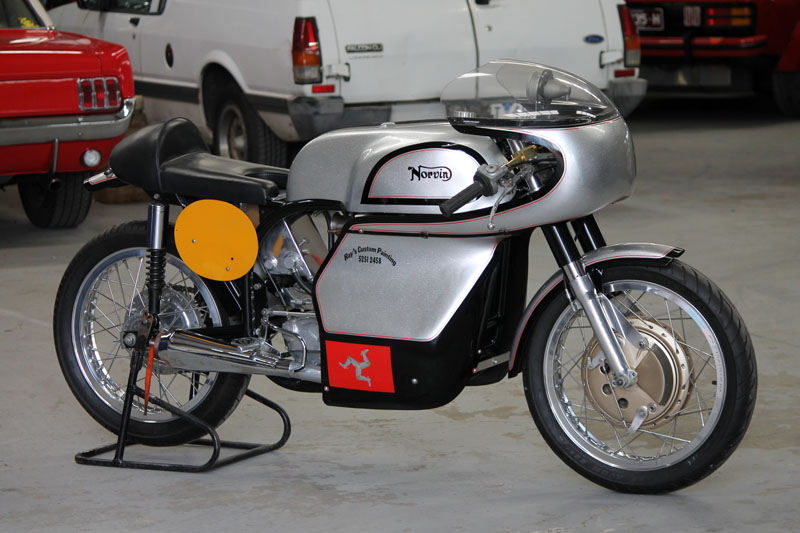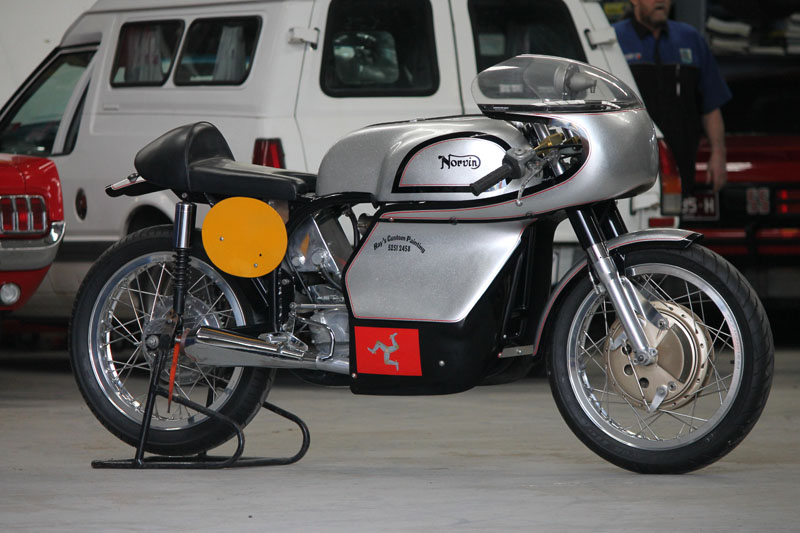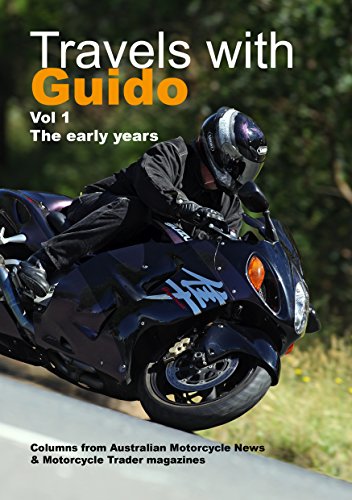Motorcycle Investor mag
Subscribe to our free email news

Feature build - one-off Norvin racer
(posted May 2020)

Flash fabrication
by Guy 'Guido' Allen
It’s one thing to restore a bike and make a few changes along the way. But to build a one-off? That’s a whole other nest of vipers
Say ‘Norvin’ to most folk, and you get a visual image of one of the legendary V-twin Vincent powerplants shoe-horned into a Norton Featherbed frame. To some eyes it’s not actually a natural fit as the Vincent unit looks huge compared to the powerplants that Norton bolted into the same space. But there’s no denying the end result looks muscular.
Done right, you end up with a bike with a more
contemporary look and improved handling.
The machine you see here, however, is a very different and
more ‘natural’ variant – a single-pot Vincent Comet engine
(in Grey Flash-plus spec) squeezed into the plot. Now
that, for some purists, is potentially a match made in
heaven. The Featherbed frame was after all made famous by
the single cylinder Manx racers.
Meet Mick McCrudden, the owner and builder of this
stunner. During the day, Mick runs a workshop called
Glenlyon Motors, which has en enviable reputation among
owners of classic and special interest cars. He builds all
sorts of interesting specials and restomods, so a visit to
the palatial shed is never dull.

However he’s also been a bike nut for decades. “At one
stage I had 13 old British bikes packed in the back yard,
until my Mum got the shits with it,” he laughs. His tastes
are eclectic and lean towards British and European
machinery, preferably with one of two cylinders. That
doesn’t stop him from having a crack at just about
anything when the opportunity arises.
He also recalls a time when old British motorcycles were
cheap: “You could get a Beeza Bantam for $20,” he
explains, shaking his head. And that was a time when he
owned a string of desirable machinery, including
Featherbed-framed Nortons and a series of Vincents. “Back
then they were cheap, but of course now they’re worth a
fortune!”
Which kind of begs the question of why Mick went down the
path of a scratch-built racer, rather than a resto that
might arguably offer greater financial rewards for the
same effort. The answer is simple: he was building
something to please himself, and what would be an ultimate
example of the breed.
This is one of those machines where you see lots of
familiar-looking components but some aren’t that easy to
place. Or there’s some nagging doubt about its origins.
The reason is this thing has an extraordinary high
custom-build factor.

As anyone who has tried it themselves, scratch-built components are a massive challenge, or pain in the arse, depending on your point of view. You’re tackling several times the workload of simply restoring an existing piece and there’s no guarantee the end result will work.
Let’s start with the frame as an example. It’s a Norton
Featherbed, Manx-style frame, yes? Well, yes and no. While
brothers Rex and Cromie McCandless – who came up with the
original as a race frame in the late 1940s – would
recognise the hugely influential twin loop design made
from Reynolds tubing, it’s not factory-built. Nope, it’s a
one-off, done with the assistance of notable Brit classic
bike builder Bob Johnson.
A former Repco and Ansett engineer, Bob guided Mick
through the process, which had plenty of challenges. “We
started with a jig based on the drawings,” explained Mick,
“But I reckon I had about 47 false starts and a lot of
written-off chrome-moly steel before I was happy!” The
whole plot features nickel-bronzed joins.

And then there’s the engine. Now you would have thought a Manx powerplant would have been appropriate, but Mick had a thing for Vincents and there is a proud history of Comet-engined Norvins. For some the Comet single is a sweeter motor than its flamboyant twin-pot sibling. In any case, Mick managed to get the base motor from local Vincent enthusiast Phil Pilgrim, of Union Jack Motorcycles.
However we’re not talking about a stock Vincent engine –
not any more. Mick decided it needed a capacity boost from
the stock 499cc and bumped it out to around 620 with the
aid of a Yamaha piston fitted with Jawa rings, matched to
a Carillo rod originally intended for a small-block
Chevrolet engine. The bottom end, by the way, has been
engineered to run on ball race bearings instead of bushes.
It’s also running a performance cam and big valves.

As if that wasn’t enough, the whole thing is set up to run
on alcohol, fed via a hand-made remote reservoir
carburettor.
So how powerful is it? That’s yet to be measured and the
bike hasn’t so far fired a shot in anger on a racetrack.
Maybe soon. In the meantime the best estimate is it should
be producing around 75 horses. If it’s anywhere within
cooee of that, it should have an impressive top speed.

Of course you need a gearbox and standard these were a
four-speed. Albion is thought to have produced a
compatible five-speed when these things were new, and Mick
undertook to do his own version, using the existing cases.
That’s complemented by a custom belt-driven diaphragm
clutch.

Think about the speed potential of this tiny narrow
package and you might start to wonder what’s been done to
finish off the chassis, assuming you have an interest in
surviving the experience. Again, Mick has gone for ‘age
appropriate’ gear, albeit up-dated and refined.

The giant quad leading shoe drum brakes seem to have a
vaguely familiar appearance. But don’t feel bad if you
can’t quite place where they came from. It is in fact a
clean-sheet design, where the patterns were done locally,
as was the casting and machining. It certainly looks the
part, with a substantial swept area and giant air scoops,
all nicely finished.

Out back, there’s a more familiar-looking bit of kit – a
Triumph twin-leading shoe conical hub. This and the front
are laced to Akront rims.
As for suspension, the crew has gone fairly conventional,
with Norton Roadholder forks up front and Manx rear
shocks.
The slick bodywork is typical of the much of the project,
with the entire thing hand-laid in fibreglass - that
includes the fuel tank.
For heaven’s sake, why not just buy some of the reasonably
plentiful off-the-shelf options out there? “I had a bee in
my bonnet about hand-building everything and not just
assembling parts,” admits Mick.
Fair enough, so how long did that take? “Ten years.” After
all that effort Mick has sold this bike to move on to the
next project. We can’t wait to see what that is…
***
Mick can be contacted via his workshop, Glenlyon Motors in Melbourne, Australia:
Tel 61 3 9380 5082
Email: mcx@glenlyonmotors.com.au
or kthow@glenlyonmotors.com.au




-------------------------------------------------
Produced by AllMoto abn 61 400 694 722
Privacy: we do not collect cookies or any other data.

Archives
Contact



